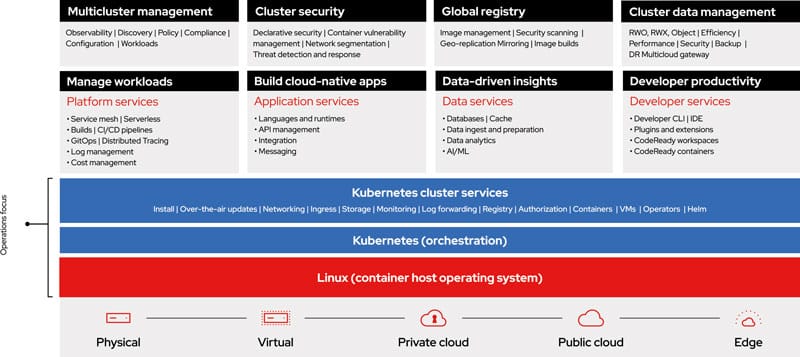Which cloud does the SAP user need?

SAP applications can no longer be seen as isolated, requirements-specific -adapted systems. Open source-based hybrid cloud platforms, integrated end-2-end architectures and automation technologies are the key to migration success - let's talk about it.
On the one hand, SAP users face the challenge of migrating to SAP HANA and SAP S/4HANA. On the other hand, they need to drive innovation in order to achieve rapid adaptability and responsiveness in a highly competitive environment. This involves both implementing SAP's "Keep the Core Clean" strategy and ensuring the extensibility of S/4HANA through modern cloud-enabled DevOps solutions. The "Keep the Core Clean" strategy recommends or requires a migration of SAP's existing in-house developments to a new architecture and platform that supports the development and operation of SAP applications with native cloud technologies.
Important aspects here are agile integration, CI (Continuous Integration) and CD (Continuous Deployment), containers and microservices, and the use of any programming languages to supplement or replace ABAP. In order to strengthen innovation, it must also be possible to implement side-by-side extensions and the integration of SAP and non-SAP solutions in hybrid end-to-end processes much more quickly.
In these modernization projects, SAP users generally face three specific challenges: First, they must use a cloud infrastructure that optimally covers their requirements, for example, with regard to the optimization and continued use of existing, traditional resources or the integration of old and new systems or processes. Secondly, they need to develop modern applications and solutions, and thirdly, they need to manage and automate hybrid cloud environments.
It must also be clear that the one cloud cannot be the answer to every challenge - otherwise modernization will quickly end in a new silo and an additional vendor lock-in with risks that are difficult to calculate and a loss of control. The good news is that this can already be conveniently avoided today with an abstraction across multiple clouds in combination with on-premises environments, even if individual cloud providers do not like to bring this to the fore.

The user's view
But which solution environments do SAP users actually need? A look at the specific challenges of the different personas can provide the answers. IT operations, cloud operations and software engineering can serve as examples here.
An IT operations manager is typically responsible for teams in the areas of Linux, Windows, storage, virtualization, networking, IT security and monitoring. Key challenges in many cases are understaffing, maintaining operations while demands increase, managing legacy systems, increasing cloud infrastructure usage, and the prevailing silo mentality. In this heterogeneous environment, an infrastructure-agnostic automation platform in particular, which also connects different silos with each other, offers decisive relief - also in terms of time.
The responsibilities of a cloud operations manager include defining a future-proof cloud architecture that also supports modern workloads in areas such as AI, ML or microservices in general. In addition, he often has to drive the transformation of applications to the cloud. Challenges in this hybrid world exist in container orchestration, end-to-end security, multi-cloud management and avoiding vendor lock-in. Kubernetes in general and Red Hat OpenShift in particular offer a solution for these requirements, as they already include, for example, cluster management, cost control and optimization across all providers, and security and governance management.
Finally, the software engineering manager must develop and deliver solutions that drive business growth; examples include new applications in Industry 4.0, IoT, Edge, AI, ML, Data Analytics or Big Data. The software development manager is confronted with tasks such as attracting and retaining talent, permanently training new engineers, dealing with multiple clouds and their tools, complying with security regulations or integrating existing solutions, at the latest now also into a modern SAP landscape. Here, too, Kubernetes and Red Hat OpenShift offer important support by providing all developer favorite tools, IDEs and frameworks like SAP API Management right away to save the developer the extremely time-consuming care and maintenance of his environment.
The solution environment
The requirements of the various personas thus specify the ideal target environment: a multi-hybrid cloud platform for SAP landscapes. It enables users to run SAP's Digital Core on-premises or on any major cloud platform.
provider to operate, even in parts or changeable over time. This should also leverage a digital core lifecycle management solution with features such as proactive monitoring, patching, or automated troubleshooting to avoid downtime in the production environment. In conjunction with an automation solution such as Red Hat Ansible Automation Platform, users can also fully automate their SAP S/4HANA migration, new deployments, or Day 2 operations, allowing IT teams to focus on innovation.
In fact, such an approach has not been proven to increase the complexity, cost or duration of migration projects. A sensible combination of requirements at an early stage results in synergies, fast ROIs, accelerated cloud utilization and still a permanently high level of flexibility. When choosing the platform that enables the management of SAP and non-SAP environments within the company and in the cloud, more and more companies are therefore opting for the enterprise Kubernetes solution Red Hat OpenShift. It supports cloud-native development of SAP S/4HANA extensions using microservices running in containers. The platform can be deployed on-premise and is additionally offered by all major cloud providers either as a managed service or natively and offers immediately usable tools for GitOps, CI/CD or multi-cluster management.
This means that all applications developed and deployed on the platform can be operated consistently across multiple environments and clouds. In principle, almost all SAP users face the same challenges. They need to meet the 2027 deadline for SAP technology modernization, reduce IT costs, and invest in agile innovation at the same time. Open source technologies, cloud-native development models and hybrid cloud environments are the business enablers par excellence, especially with regard to the implementation of the digital transformation. SAP users can use them to migrate their own ABAP developments and integrate new end-to-end processes with SAP. Last but not least, they gain maximum strategic flexibility through cloud-agnostic multi-hybrid cloud use - in line with the guiding principle "Develop once - deploy anywhere".





